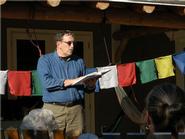
Maurice Isserman, Hamilton College's James L. Ferguson Professor of History, will discuss Fallen Giants - A History of Himalayan Mountaineering from the Age of Empire to the Age of Extremes on Wednesday, Sept. 17, at 4:15 p.m. at the Glen House on Hamilton's campus. Isserman, who co-authored the book, will also sign copies. Published by Yale University Press last month, the book has been nominated for a Pulitzer Prize. The bookstore will have copies of the book available for sale at the event which is free and open to the public.
Fallen Giants is a comprehensive history of Himalayan mountaineering, which begins in 1890 and offers detailed, original accounts of the most significant climbs since the 1890s. Isserman and his co-author, University of Rochester Professor Stewart Weaver, also address the social and cultural worlds that gave rise to those expeditions. In praise of the book, two-time Everest climber Conrad Anker said, "Maurice Isserman and Stewart Weaver capture the essence of Himalayan climbing in an authentic voice."
Sixty-five photographs and 15 maps complement the descriptions of climbs including the first successful ascent of Mount Everest in 1953 and less well-known tales of many other adventurers. The book recounts the experiences of such figures as Martin Conway, who led the first authentic Himalayan climbing expedition in 1892; Fanny Bullock Workman, the pioneer explorer of the Karakoram range; George Mallory, the romantic martyr of Mount Everest fame; Charlie Houston, who led American expeditions to K2 in the 1930s and 1950s; Ang Tharkay, the legendary Sherpa, and many others.
Throughout, the authors discuss the effects of political and social change on the world of mountaineering, and they offer analysis of a culture that once emphasized teamwork and fellowship among climbers, but now has been eclipsed by a scramble for individual fame and glory.
Both authors are enthusiastic hikers and mountain climbers.
Fallen Giants is a comprehensive history of Himalayan mountaineering, which begins in 1890 and offers detailed, original accounts of the most significant climbs since the 1890s. Isserman and his co-author, University of Rochester Professor Stewart Weaver, also address the social and cultural worlds that gave rise to those expeditions. In praise of the book, two-time Everest climber Conrad Anker said, "Maurice Isserman and Stewart Weaver capture the essence of Himalayan climbing in an authentic voice."
Sixty-five photographs and 15 maps complement the descriptions of climbs including the first successful ascent of Mount Everest in 1953 and less well-known tales of many other adventurers. The book recounts the experiences of such figures as Martin Conway, who led the first authentic Himalayan climbing expedition in 1892; Fanny Bullock Workman, the pioneer explorer of the Karakoram range; George Mallory, the romantic martyr of Mount Everest fame; Charlie Houston, who led American expeditions to K2 in the 1930s and 1950s; Ang Tharkay, the legendary Sherpa, and many others.
Throughout, the authors discuss the effects of political and social change on the world of mountaineering, and they offer analysis of a culture that once emphasized teamwork and fellowship among climbers, but now has been eclipsed by a scramble for individual fame and glory.
Both authors are enthusiastic hikers and mountain climbers.
Posted September 15, 2008
